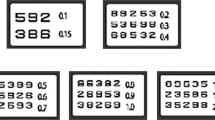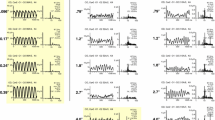Abstract
Background
To determine the value of the distance doubling visual acuity test in the diagnosis of nonorganic visual loss in a comparative observational case series.
Methods
Twenty-one consecutive patients with nonorganic visual acuity loss and 21 subjects with organic visual loss as controls were included. Best corrected visual acuity was tested at the normal distance of 5 meters using Landolt Cs. The patient was then repositioned and best corrected visual acuity was tested with the previous optotypes at double the distance via a mirror.
Results
Nonorganic visual acuity loss was identified in 21 of 21 patients. Sensitivity and specificity of distance-doubling visual acuity test in functional visual loss were found to be 100% (CI; 83%–100%) and 100% (CI; 82%–100%), respectively.
Conclusion
Distance doubling visual acuity test is widely used to detect nonorganic visual loss. Our results show that this test has a high specificity and sensitivity to detect nonorganic visual impairment.

Similar content being viewed by others
References
Kathol RG, Cox TA, Corbett JJ, Thompson HS (1983) Functional visual loss: follow-up of 42 cases. Arch Ophthalmol 101:729–735
Keltner JL, May WN, Johnson CA, Post RB (1985) The California syndrome: functional visual complaints with potential economic impact. Ophthalmology 92:427–435
Ramke J, Palagyi A, Naduvilath T, du Toit R, Brian G (2007) Prevalence and causes of blindness and low vision in Timor-Leste. Br J Ophthalmol 91(9):1117–1121, doi:10.1136/bjo.2006.106559
Miller BW (1973) A review of practical tests for ocular malingering and hysteria. Surv Ophthalmol 17:241–246
Miller NR, Keane JR (1998) Neuro-ophthalmologic manifestations of nonorganic disease. In: Miller NR, Newman NJ (eds) Walsh and Hoyt’s Clinical Neuro-ophthalmology, vol. 1, 5th edn. Williams & Wilkins, Baltimore, pp 1765–1786
Keane JR (1982) Neuro-ophthalmic signs and symptoms of hysteria. Neurology 32:757–762
Helmbold X (1896) Ueber simulation. Monatsbl Augenheilkd 34:217–218
Mojon DS, Flueckiger P (2002) A new optotype chart for detection of nonorganic visual loss. Ophthalmology 109(4):810–815, doi:10.1016/S0161-6420(01)01050-8
Bach M, Maurer JP, Wolf ME (2008) Visual evoked potential-based acuity assessment in normal vision, artificially degraded vision, and in patients. Br J Ophthalmol 92(3):396–403, doi:10.1136/bjo.2007.130245
Funding
The study was partly funded by the OPOS Foundation, Stiftung zugunsten von Wahrnehmungsbehinderten, St. Gallen, Switzerland
Author information
Authors and Affiliations
Corresponding author
Rights and permissions
About this article
Cite this article
Zinkernagel, S.M., Mojon, D.S. Distance doubling visual acuity test: A reliable test for nonorganic visual loss. Graefes Arch Clin Exp Ophthalmol 247, 855–858 (2009). https://doi.org/10.1007/s00417-008-1019-9
Received:
Revised:
Accepted:
Published:
Issue Date:
DOI: https://doi.org/10.1007/s00417-008-1019-9




